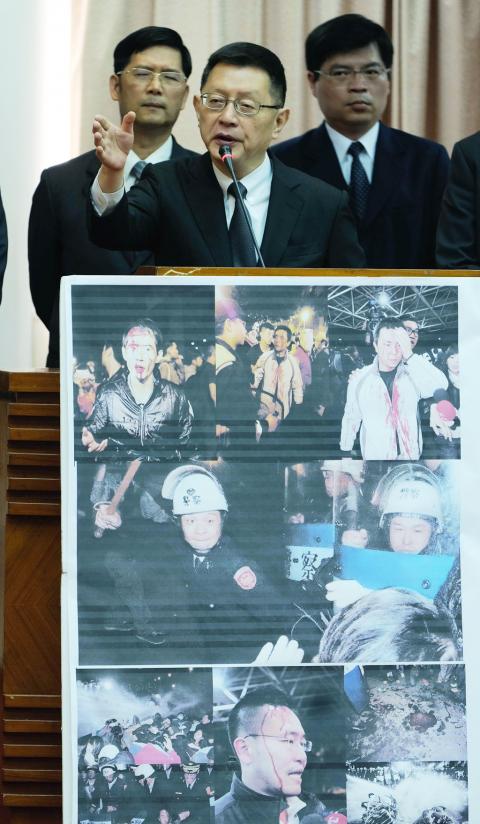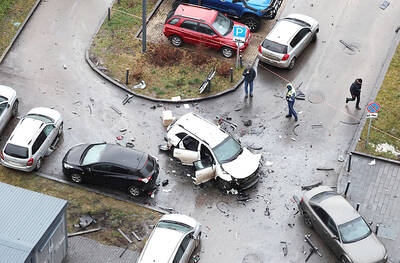Despite being shown pictures and video footage of protesters bleeding or being beaten up by police officers, law enforcement officials yesterday denied that the police had used excessive force as they evicted protesters from the Executive Yuan complex in Taipei early on Monday.
National Police Agency (NPA) Director-General Wang Cho-chiun (王卓鈞) told a meeting of the legislature’s Internal Administration Committee that “all police officers observed the code of conduct” in dispersing the protesters.
Wang, Minister of the Interior Chen Wei-zen (陳威仁) and Executive Yuan Secretary-General Lee Shu-chuan (李四川) were present at the committee meeting called by Democratic Progressive Party (DPP) lawmakers to investigate what has been termed a “bloody crackdown on unarmed students.”

Photo: Sam Yeh, AFP
Thousands of protesters, mainly students, occupied the Executive Yuan on Sunday night to increase pressure on the government to respond to their demands to revoke the cross-strait service trade agreement and enhance legislative oversight of cross-strait negotiations.
The DPP organized the meeting in response to Premier Jiang Yi-huah’s (江宜樺) comments that the police “acted in a rational and peaceful way” by either lifting the protesters up from the ground or patting their shoulders.
In response to media inquiries, Wang said before the meeting began that the police’s dispersal actions should not be described as use of violence.
“How could the carrying out of police duties be called ‘use of violence?’” Wang said.
Considering that there was a confrontation between appropriately 5,000 protesters and 2,700 police officers and the police needed to disperse the crowd, “it was inevitable that some people were left bleeding,” Wang said.
The eviction of protesters was carried out in a much less cruel way than it would have been other countries, Wang said.
Wang said he “was praised by then-premier Yu Shyi-kun (游錫堃)” of the DPP for his lead of the police force in forcibly removing protesters at a rally against the DPP government after the 2004 presidential election.
DPP Legislator Tuan Yi-kang (段宜康) displayed a picture of a female protester whose hands were tied behind her back by one officer and her hair pulled by another officer, while a third wrapped his arms around her neck.
Another picture provided by Tuan showed that expandable steel batons, which could cause grave injury or death, were also used by the police in the dispersal, which Wang first denied, but then admitted.
Holding a big poster showing several pictures of bleeding protesters, DPP Legislator Chiu Yi-ying (邱議瑩) stood in front of Wang, Lee, and Chen Wei-zen, so they could take a close look at the pictures.
Displaying pictures of protesters whose heads were covered in blood, DPP Legislator Chiu Chih-wei (邱志偉) demanded an answer to why the police attacked the protesters.
Although the pictures displayed by Chiu Chih-wei had been published in newspapers on Monday and Tuesday, Chen Wei-zen said that he “had never seen these pictures before.”
Wang said the NPA did not ask the police to target protesters heads.
“If we had given the order, the outcome today would have been different,” he said.
A footage shot by reporters with the Chinese-language Next Magazine showed a SWAT officer using his baton to hit a protester’s head twice while the man was lying on the ground and people surrounding them were shouting: “No more hitting.”
“It is the shame of the nation” that the police confronted unarmed students using such brutal force, while “you were still so shamelessly boasting about the dispersal operations that day, Chiu Chih-wei said.
In the police reports presented to the committee, the officials said the protesters “did not act with restraint,” the law enforcement measures adopted by the police during the eviction were “appropriate” and that “injuries were caused when the police and the protesters pushed and shoved each other.”
The DPP lawmakers rejected the written reports.
Among the 170 people injured in the eviction was Taiwan Solidarity Union (TSU) Legislator Chou Ni-an (周倪安).
Footage provided by TSU Legislator Lai Cheng-chang (賴振昌) showed that Chou was trying to protect a protester while police were pulling and dragging protesters, sitting on the ground with their arms linked.
Chou, who was still in hospital as of press time, was badly beaten by the police while officers took cover behind shields, Lai said.
“You could have had two female police pull her [Chou] away because she is petite. Did she pose any danger to police?” Lai said.
In response, Wang said there had been “negligence” by law enforcement in Chou’s case.
Wang was repeatedly questioned by DPP lawmakers throughout the eight-hour meeting, during which more images of injured people were displayed.
When asked to apologize over the use of excessive police force, Wang said: “I cannot apologize before it is clear what happened in each case.”
The DPP lawmakers said that police had violated several regulations in the Police Power Exercise Act (警察職權行使法) and the Statute Governing Use of Arms by the Police (警械使用條例).
Chen Wei-zen, Wang and Lee again defended the use of force in dispersing the protesters after questions from DPP Legislator Kuan Bi-ling (管碧玲).
They said that they would like to apologize for “disturbances to the public caused by the dispersal operation,” but insisted that whether the police had used excessive force or any illegal instruments could not be determined until the situation was clarified.
DPP Legislator Chen Chi-mai (陳其邁) asked the trio to say how they felt about the pictures and video footage.
“Do you feel the same way I do?” he asked.
The three said they “could not bear to see” the images.
“I wish the situation had not happened,” Wang said.
Wang said he was ordered by Jiang to “forcibly disperse” the protesters.
The order he gave to Taipei City Police Department Commissioner Huang Sheng-yung (黃昇勇) and Zhongzheng First Precinct Police Chief Fang Yang-ning (方仰寧), who were commanders in charge at the scene, was that police disperse the protesters “with all their strength.”
Huang and Fang did not appear before the committee for questioning.
The committee adopted a series of resolutions about Monday’s events.
Among them was a condemnation of President Ma Ying-jeou (馬英九), Jiang, Wang and Chen Wei-zen for the “bloody crackdown” carried out by police and a demand that Wang resign.
Executive Yuan spokesperson Sun Lih-chyun (孫立群) called a press conference at 7:50pm.
Sun said Jiang had highly commended Wang and the police and would “very much like to have Wang stay in his position.”
The rumor that the government had asked Wang to resign to take responsibility for the Executive Yuan being occupied “was untrue,” Sun said.
Jiang dismissed the “bloody crackdown” label and censured media outlets and political parties over the allegation, Sun said.
Separately yesterday, Yu said police in 2004 were forced to resort to tougher measures because protesters attacked them with molotov cocktails and iron bars.
Additional reporting by Chris Wang

TRAGEDY STRIKES TAIPEI: The suspect died after falling off a building after he threw smoke grenades into Taipei Main Station and went on a killing spree in Zhongshan A 27-year-old suspect allegedly threw smoke grenades in Taipei Main Station and then proceeded to Zhongshan MRT Station in a random killing spree that resulted in the death of the suspect and two other civilians, and seven injured, including one in critical condition, as of press time last night. The suspect, identified as a man surnamed Chang Wen (張文), allegedly began the attack at Taipei Main Station, the Taipei Fire Department said, adding that it received a report at 5:24pm that smoke grenades had been thrown in the station. One man in his 50s was rushed to hospital after a cardiac arrest

A car bomb killed a senior Russian general in southern Moscow yesterday morning, the latest high-profile army figure to be blown up in a blast that came just hours after Russian and Ukrainian delegates held separate talks in Miami on a plan to end the war. Kyiv has not commented on the incident, but Russian investigators said they were probing whether the blast was “linked” to “Ukrainian special forces.” The attack was similar to other assassinations of generals and pro-war figures that have either been claimed, or are widely believed to have been orchestrated, by Ukraine. Russian Lieutenant General Fanil Sarvarov, 56, head

SAFETY FIRST: Double the number of police were deployed at the Taipei Marathon, while other cities released plans to bolster public event safety Authorities across Taiwan have stepped up security measures ahead of Christmas and New Year events, following a knife and smoke bomb attack in Taipei on Friday that left four people dead and 11 injured. In a bid to prevent potential copycat incidents, police deployments have been expanded for large gatherings, transport hubs, and other crowded public spaces, according to official statements from police and city authorities. Taipei Mayor Chiang Wan-an (蔣萬安) said the city has “comprehensively raised security readiness” in crowded areas, increased police deployments with armed officers, and intensified patrols during weekends and nighttime hours. For large-scale events, security checkpoints and explosives

PUBLIC SAFETY: The premier said that security would be tightened in transport hubs, while President Lai commended the public for their bravery The government is to deploy more police, including rapid response units, in crowded public areas to ensure a swift response to any threats, President William Lai (賴清德) said yesterday after a knife attack killed three people and injured 11 in Taipei the previous day. Lai made the remarks following a briefing by the National Police Agency on the progress of the investigation, saying that the attack underscored the importance of cooperation in public security between the central and local governments. The attack unfolded in the early evening on Friday around Taipei Main Station’s M7 exit and later near the Taipei MRT’s Zhongshan